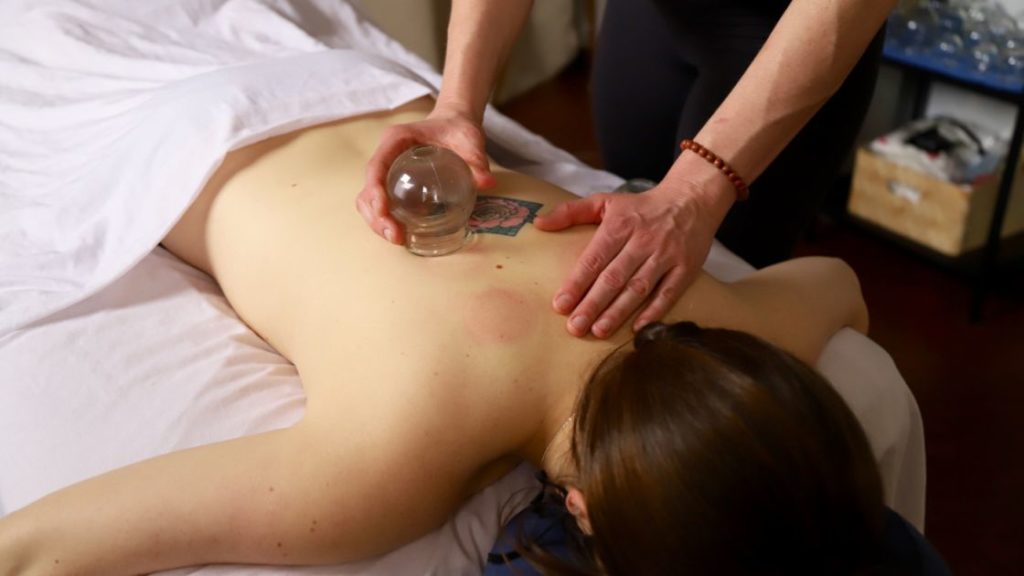Is Massage Cupping Right for You?

Cupping is a great compliment to traditional hands-on massage.
You’ve no doubt heard of massage cupping. Maybe a friend said they received it or you’ve seen those marks on your favorite pro athlete and now you’re curious. But what does cupping really do?
What Are the Benefits?
There are many benefits of cupping primarily attributed to the increase of circulation of blood and lymph. Improving circulation helps to release stagnant blood and metabolic waste from deep in the tissue which acts to loosen and relax the tissue. The mechanical action of cupping hydrates and separates the various layers of tissue, skin, fascia, muscle, tendon etc. Cupping also helps to break down adhesions (knots) and scar tissue. Additionally, the movement of blood, interstitial fluid and lymph can help improve immunity and reduce inflammation.
- Improves circulation and blood flow
- Release scar tissue, knots and fascial adhesions
- Hydrates and separates tissue layers (fascia, muscle, skin, adipose etc)
- Promotes relaxation
- Increases flexibility and mobility of joints
- Reduces pain
- Reduces inflammation
- Boosts cellular immunity and the lymphatic system
Conditions Treated with Cupping Massage
Cupping is great for relieving chronic muscle tension and pain and can be used to treat conditions affecting tendons, ligaments, joints and other myofascial issues.
- Lower back pain/tension
- Neck and shoulder pain/tension
- Headache and migraine/tension
- Knee pain/tension
- Wrist/forearm pain/tension
- Joint issues especially elbow, shoulder, spine/rib and knee
- Scars, scar tissue
- Tendinitis, bursitis
- Plantar fasciitis
- Facial paralysis
- Fibromyalgia
- Release of trigger points
Getting Cupped
The sensation of cupping is hard to describe. The cup is creating a vacuum or negative pressure which is not something we often experience. However, many clients say it feels similar to hands-on massage – relaxing and soothing. Cups are usually applied lighter and for less time with a new client to allow them time to adjust to the new experience.
Cupping can be incorporated into a traditional hands-on massage a lot or a little. If you’re new to cupping, I recommend starting with less. A few cups applied with lighter pressure to one place for about 5-10 minutes. This type of cupping is known as static cupping and it is a more targeted approach to addressing a chronic or stubborn issue and is especially useful on knots, adhesions, scar tissue and muscle tension. Another type of cupping is known as dynamic cupping. Here the cups are moved over the skin in a gliding motion – many clients say this is very relaxing. As a client gets more accustomed to the experience of cupping, the number of cups, the amount of negative pressure and duration cupping can be increased.
How to Prepare for Your First Cupping Session
- Hydrate, hydrate, hydrate
- Eat at least a small meal
- Avoid sun exposure to the area you want cupped
- Get plenty of sleep
- Avoid alcohol for 1-2 days before your session
Post Cupping Care
- Drink lots of water. It’s important to support the movement of the fluids from cupping by drinking plenty of water.
- Add electrolytes to your water if this is something you’ve done in the past during hard workouts or other activities. This will further support your hydration
- Eat nutritious food such as fresh fruits and lots of veggies
- Don’t skip meals, keep your blood sugar steady
- Avoid alcohol for at least 2 days. Alcohol is hard on your kidneys and liver which are working hard to filter all the material cupping released
When Not to Use Cupping
- On sunburned skin
- On open wounds or fresh scars
- On any inflamed or irritated skin
- On those who take blood thinners
- On those with unmanaged high blood pressure, heart conditions or advanced diabetes
- On varicose veins or surface veins
Myths About Cupping
- “It is painful.” While it can look scary, the actual experience is usually one of deep relaxation. If the cups do feel uncomfortable or too tight, simply tell your practitioner and they can lessen the suction.
- “It bruises the skin.” The marks left by cupping are a result of stagnant blood, cellular waste and lymph being brought to the surface of the skin, whereas a bruise is a result of trauma, tissue and capillary damage.
- “Cupping will reduce the amount of time I’m getting hands-on massage treatment.” In my sessions I tailor the amount of cupping used to the client. Usually I use cupping as a compliment to traditional hands-on massage. Often cups are placed on the back (or other problem area) for 5-10 minutes in one area and moved around while I work another area. In truth, it’s like getting a four-hand massage because the cups work in one area while I work another!
- “Cupping is only for athletes.” All types of people can benefit from cupping and in fact, it has great benefits for those who experience chronic muscle tension especially in the upper back and shoulders. Cupping is also great for improving mobility in areas with lots of scar tissue like mastectomies or rotator cuff repairs.
- “Cupping is just a fad.” Although cupping has been getting more attention in recent years, it has been around for centuries and has been practiced all over the world in ancient cultures as diverse as Egyptian, Chinese, African, Middle Eastern and South American! In fact, the first documented use of cupping is from an Egyptian papyrus dated to 1550 BCE.
Now that you know more about cupping, call Moyer Total Wellness and schedule your massage cupping session today!

Liz Edelman
Author, Licensed Massage Therapist, Certified Cupping Therapist
Liz Edelman is a certified Rolfer®, licensed massage therapist, certified cupping therapist, energy healing practitioner and certified personal trainer! Liz’s interest in the body developed with a late introduction to sports and fitness in her 20s and 30s through running, kettlebell lifting and Olympic weightlifting. What started as a fitness journey led to a desire to share her love of movement with others. In 2016, Liz began instructing and coaching at Colorado Weightlifting Club. Her experience with fitness demonstrated the potential we have in maintaining or improving health by combining movement and care of the body such as proper nutrition, sleep, stress reduction and bodywork (i.e. Chiropractic, Rolfing® and massage).
Resources
“7 Surprising Benefits of Cupping Massage • Resolution Health.” Resolution Health, 24 Apr. 2019, resolution.health/2019/04/24/surprising-benefits-of-cupping-massage/.
Ansorge, Rick. “Cupping Therapy.” WebMD, WebMD, 28 Aug. 2012, www.webmd.com/balance/guide/cupping-therapy.
“Benefits of Cupping Therapy – Central Nebraska Rehab Services.” Www.cnrehab.com, www.cnrehab.com/news/learn-about-cupping-therapy.html.
Essentials, Lure. “WHAT IS CUPPING THERAPY – COMMON MYTHS, SAFETY, BENEFITS and MORE.” Lure Essentials, 18 Jan. 2019, lureessentials.com/blogs/news/what-is-cupping-therapy-common-myths-safety-benefits-and-more. Accessed 9 Feb. 2023.
Marcin, Ashley, and Crystal Hoshaw. “What Is Cupping Therapy?” Healthline, 2019, www.healthline.com/health/cupping-therapy.
Romeril, Phil. “The History of Cupping.” Melbourne Natural Therapies, 9 Sept. 2019, melbournenaturaltherapies.com.au/the-history-of-cupping/#:~:text=In%20the%20Chinese%20tradition%2C%20the.
